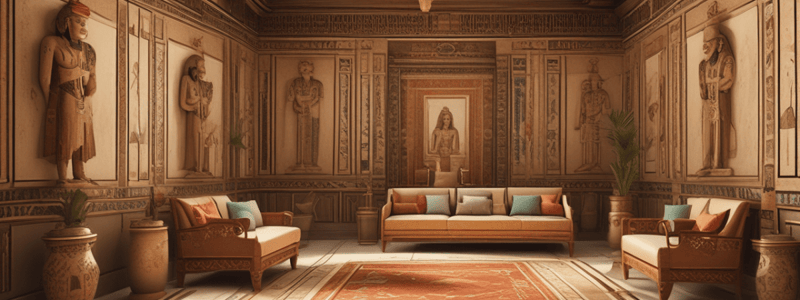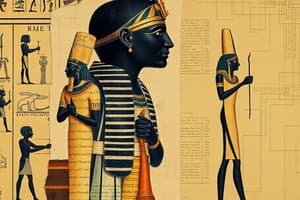Podcast
Questions and Answers
What is a peristyle court?
What is a peristyle court?
- A living room for social gatherings
- An opening to allow rainwater to collect into the pool
- A court surrounded by a covered walkway (correct)
- A small recess or pool
Which material was not used in the construction of Greek furniture?
Which material was not used in the construction of Greek furniture?
- Plastic (correct)
- Bronze
- Marble
- Iron
Which type of furniture had concave backs?
Which type of furniture had concave backs?
- Stool
- Threnys
- Kathisma
- Thronos (correct)
What is faience made of?
What is faience made of?
Which term means 'trompe l'oeil'?
Which term means 'trompe l'oeil'?
Where would you typically find an impluvium in a Greek interior?
Where would you typically find an impluvium in a Greek interior?
What material were Egyptian houses and shops made of?
What material were Egyptian houses and shops made of?
What is the purpose of clerestory windows in larger homes?
What is the purpose of clerestory windows in larger homes?
Which item of furniture is the most common in Egyptian households?
Which item of furniture is the most common in Egyptian households?
What were the legs of Egyptian furniture commonly modeled after?
What were the legs of Egyptian furniture commonly modeled after?
What were Egyptian chests commonly used for?
What were Egyptian chests commonly used for?
What types of roofs did Egyptian houses and shops typically have?
What types of roofs did Egyptian houses and shops typically have?
What is the purpose of the 'Atrium' in a Roman house?
What is the purpose of the 'Atrium' in a Roman house?
Which Roman interior feature was specifically used for dining and reclining?
Which Roman interior feature was specifically used for dining and reclining?
What is a 'Compluvium'?
What is a 'Compluvium'?
Which feature is located at the end of the atrium?
Which feature is located at the end of the atrium?
How were the floors of important rooms in Roman homes often decorated?
How were the floors of important rooms in Roman homes often decorated?
Which of the following was NOT typically part of Roman interior wall decoration?
Which of the following was NOT typically part of Roman interior wall decoration?
Which type of furniture was the first chair with a cushion and originally a folding stool?
Which type of furniture was the first chair with a cushion and originally a folding stool?
What feature characterizes the Solium type of chair?
What feature characterizes the Solium type of chair?
Which feature was NOT commonly used on historical furniture?
Which feature was NOT commonly used on historical furniture?
What is the defining characteristic of the 'Tripod' type of furniture?
What is the defining characteristic of the 'Tripod' type of furniture?
Which type of furniture is a chaise specifically designed for women?
Which type of furniture is a chaise specifically designed for women?
What does the name of the semi-circular reclining couch come from?
What does the name of the semi-circular reclining couch come from?
What materials were used to inlay the elaborate chairs for the wealthy?
What materials were used to inlay the elaborate chairs for the wealthy?
What kind of decorative item often tells a story of historical events in Romanesque interiors?
What kind of decorative item often tells a story of historical events in Romanesque interiors?
What is notable about the furniture used for ecclesiastical and domestic purposes during the Romanesque period?
What is notable about the furniture used for ecclesiastical and domestic purposes during the Romanesque period?
What feature characterized the homes of the rich during the Byzantine period?
What feature characterized the homes of the rich during the Byzantine period?
What was the primary function of an aumbry in the bedchamber?
What was the primary function of an aumbry in the bedchamber?
What object is described as a sideboard for holding food?
What object is described as a sideboard for holding food?
Which type of cupboard was made with stepped tiers for grandiose display?
Which type of cupboard was made with stepped tiers for grandiose display?
What was the optional feature of a buffet that served as a status symbol?
What was the optional feature of a buffet that served as a status symbol?
What items were kept in an aumbry besides the overnight ration of food?
What items were kept in an aumbry besides the overnight ration of food?
What was the 'The Great Hall' principally used for?
What was the 'The Great Hall' principally used for?
Which item was not a common motif in the decorative elements?
Which item was not a common motif in the decorative elements?
What is a 'Trestle table'?
What is a 'Trestle table'?
In VL Gothic interiors, what covered the floors?
In VL Gothic interiors, what covered the floors?
What was the purpose of tapestries after 1400?
What was the purpose of tapestries after 1400?
What is unique about the 'fold stool' or 'cathedra'?
What is unique about the 'fold stool' or 'cathedra'?
What was the 'Chair of the Estate' reserved for?
What was the 'Chair of the Estate' reserved for?
What characterized the construction of primitive dug-out type furniture?
What characterized the construction of primitive dug-out type furniture?
Which of the following was a characteristic of Italian Baroque interior treatment?
Which of the following was a characteristic of Italian Baroque interior treatment?
Which element was common in the furniture of Italian Rococo?
Which element was common in the furniture of Italian Rococo?
Which of the following was NOT a feature of French Renaissance interior treatment?
Which of the following was NOT a feature of French Renaissance interior treatment?
Which of the following describes the typical stairways in Italian Baroque interiors?
Which of the following describes the typical stairways in Italian Baroque interiors?
What is 'quadratura' in the context of Italian Baroque interiors?
What is 'quadratura' in the context of Italian Baroque interiors?
Which statement is true regarding Italian Rococo furniture?
Which statement is true regarding Italian Rococo furniture?
What type of chair is specifically designed for women?
What type of chair is specifically designed for women?
Which piece of furniture is an X-shaped chair named after a monk?
Which piece of furniture is an X-shaped chair named after a monk?
Which chair's design extends the front curule as arm supports and the back curule as uprights of the back?
Which chair's design extends the front curule as arm supports and the back curule as uprights of the back?
Which type of furniture is a bed placed on a base, with a canopy and panelled footboard?
Which type of furniture is a bed placed on a base, with a canopy and panelled footboard?
Which chair is similar to the Sgabello but features three splayed legs instead of two trestle supports?
Which chair is similar to the Sgabello but features three splayed legs instead of two trestle supports?
What type of ceiling treatment was commonly used in Italian Renaissance interiors?
What type of ceiling treatment was commonly used in Italian Renaissance interiors?
What type of furniture is a 'Cassone' known to be?
What type of furniture is a 'Cassone' known to be?
Which type of flooring was occasionally used in Italian Renaissance interiors?
Which type of flooring was occasionally used in Italian Renaissance interiors?
In the High Renaissance period, which type of room was intended for meditation and study?
In the High Renaissance period, which type of room was intended for meditation and study?
What were fireplaces in Italian Renaissance interiors typically ornamented with?
What were fireplaces in Italian Renaissance interiors typically ornamented with?
What is 'cartouche' in the context of Italian Renaissance interiors?
What is 'cartouche' in the context of Italian Renaissance interiors?
Which type of tiles were used for walls in Italian Renaissance interiors?
Which type of tiles were used for walls in Italian Renaissance interiors?
Which of these types of carving was used in furniture decoration during the Italian Renaissance?
Which of these types of carving was used in furniture decoration during the Italian Renaissance?
Study Notes
History of Interior and Furniture Design
1. Egypt
A. Interiors
- Houses and shops were made of sun-dried bricks with flat roofs and small slit windows to keep the sun out.
- Consisted of a small construction, large central living room, and 2-3 other rooms.
- Stairs led to a roof.
- Larger homes had clerestory windows under a roof raised above the house.
- Floors were painted with special hard plaster with flowers, plants, birds, and fishes.
- Ceilings were blue and brightly painted columns supported tiled roof.
- White-washed interiors.
B. Parts of a house
- Loggia: a roofed gallery.
- Portico: a roofed porch upheld by a column.
- Tripartite plan: a plan consisting of a reception room, central hall/living room, and private areas.
C. Furniture Elements
- Bull's hooves or lion's paws for legs.
- Lathe-turned parts with tongue and groove (T & G) construction.
D. Furniture Types
- Stool: the most common of Egyptian furniture, invented the collapsible stool.
- Chest: an important part of Egyptian household collection, highly decorated, large ones for linen, and small ones for cosmetics and jewelry.
- Rush/leather seats.
- Varnish or gesso for finishing.
- Tables: for eating, writing, and gaming.
- Bed.
- Chair: used by important people.
Greek
- Interiors: rooms around a court, the largest room was usually the most decorated.
- Parts: atrium, peristyle court, compluvium, impluvium, living room, store rooms, kitchen, and bathroom.
- Accessories: faience, made of powdered quartz and coated with a vitreous paste.
Dining room (andron)
- Interior treatment: walls, floors, pavement or mosaics, ceilings, and furniture elements.
- Furniture elements: materials, dog's foot/lion's paw for legs, and concave backs.
- Furniture types: stool, thronos, and threnos.
Roman Interiors
- Vestibule: entrance of the home.
- Reception room: central hall of the house with an opening in the roof.
- Atrium: the roofed courtyard.
- Compluvium: the large opening in the roof which let in light and collected rain.
- Impluvium: the water catcher.
- Tablinum: located at the end of the atrium, this was the sacred area where the nuptial bed and dining table were kept.
- Triclinium: the dining room with reclining couches.
- Cubicula: small bedrooms.
- Exedra: kitchen and used for conversations.
- Peristyle court: the courtyard surrounding the garden.
- Kline: bed or couch for eating during the day and sleeping at night.
- Tripods: three-legged tables.
- Chest: furniture for storing items.
Roman Interior Design
- Interior treatment: lavishly decorated, with a passion for luxurious materials, techniques, and illusionistic devices.
- Floors: covered in mosaic tiles, particularly in important rooms.
- Walls: adorned with stuccowork, frescoes, and trompe l'oeil.
Furniture Elements
- Rich fabrics and cushions.
- Little underbracing for legs.
- Designs were derived from Greek models.
- Massive and elaborately decorated.
- Turned legs, animal feet, sphinxes, and griffins were used.
Furniture Types
- Curule: the first chair with a cushion, an x-shaped chair originally a folding stool.
- Bisellíum: double chair or settle.
- Solium: throne chair for men, with an animal.
- Cathedra: chaise for women.
- Scamnum/subselium: bench.
- Monopodium: table with a single column or support.
- Tripod: three-legged table.
Romanesque
- Interior Accessories: tapestry, embroidery in wool-thread and usually tells a story of historical events.
- Illuminated manuscripts.
- Furniture characteristics: mostly ecclesiastical purposes, but there is no difference between ecclesiastical and domestic furniture pieces.
- Furniture types: chest.
Byzantine
- Interiors: homes of the rich opened onto courtyards protected from the street by a stone wall.
- Oriental rugs: very rare.
- The Great Hall: principally used for the assemblies of vassals, banquets, trials, and entertainments.
- Decorative motifs: arches, tracery, foliage, linen fold carving, pierced carving, and pointed arch.
- Furniture elements: wooden construction, decorations were painted and then carved, and presence of Gothic motifs.
- Furniture types: chest or coffer, stool, full-tester bed or four-poster bed, throne chair or "Chair of the Estate", and trestle table.
VL Gothic
- Interior treatment: walls, ceilings, and floors.
- Tapestries: became famous after 1400 to cover walls, decorate furniture, or partition rooms.
- Primitive dug-out type: made by hollowing out a log.
- The ark: had a gabled detachable lid.
- Dome type standard: a standard design.
- Boarded type or six-plank chest: a type of chest.
- The high hutch: a type of furniture.
- Fold stool/cathedra: x-shaped stool for women with implied authority.
- "Chair of the Estate": reserved for the lord and master.
- Sella curulis: x-framed chair.
Aumbry (later, livery cupboard)
- Stood in the bedchamber to store overnight ration of food and refreshment.
- Used to keep sacred vessels, books, reliquaries, and oils.
Credence or serving table
- A sideboard for holding food.
Buffet/cupboard
- A large construction of stepped tiers for grandiose display, the number of tiers being specified according to rank.
Refectory Table
- A long, narrow table having a single stretcher between trestle-like supports at the ends.
Italian Renaissance
- Interior Treatment: interiors consisted of smaller rooms, but larger in scale as compared to today's rooms.
- Coffered and beamed ceilings, and flat plaster ceilings were also used.
- Pilasters, niche, and large paintings were incorporated into the architectural design.
- Majolica tiles were used for walls.
- Windows were either square-headed or topped with a pediment.
- Black-and-white, colored, or terrazzo floors were used, with occasional Oriental rugs.
- Fireplaces were ornamented with mantles, and bolection moldings were typical.
- Cartouche: a medallion or coat of arms often decorating the ceiling.
- Furniture was used sparingly.
Furniture Elements
- Monumental in character.
- Upholstered seats.
- Ornamented nail heads used with leather upholstery.
- Gesso-painted or gilded.
- Furniture decoration included certosina, intarsia, incised carving, chip carving, and pastiglia.
Furniture Types
- Cassone (marriage chest): often made in pairs, to contain the bride's trousseau.
- Cassapanca: a large cassone with back and arms added to form a settee or sofa.
- Credenza (sideboard): sideboards with boards often surmounted by drawers intended for the storage of linen, dishes, and silverware.
Italian Baroque
- Interior Treatment: grand proportions of rooms, great emphasis on fresco painting, carved woodwork in paint or gold, quadratura, floors, walls, windows, and doors.
Furniture Elements
- Spanish influence was evident in the black and white cabinets produced in Italy.
Italian Rococo
- Furniture Elements: proportions were usually awkward, much gilding was used, lacquer was employed, and chinoiserie was used.
- Furniture Types: Venetian mirror, 3-paneled with etches or frosted glass.
French Renaissance
- Interior Treatment: emphasis on symmetry, rectangular plans, and uniform spacing.
- Furniture:
- Sedia: armchair for men.
- Sgabello: light wooden chair for women.
- Savonarola: x-shaped chair named after a monk.
- Dante/Dantesque: usually of tooled leather, curule in front extend as arm supports while the curule at the back extended as uprights of the back.
- Panchetto: similar to the sgabello but had three splayed leg instead of two trestle supports.
- Letto: bed with massive structure placed on a base, a canopy, and panelled footboard.
Studying That Suits You
Use AI to generate personalized quizzes and flashcards to suit your learning preferences.
Description
Explore the ancient Egyptian interior design principles, including house construction, room layout, and decorative elements. Learn about the use of sun-dried bricks, flat roofs, and clerestory windows.





